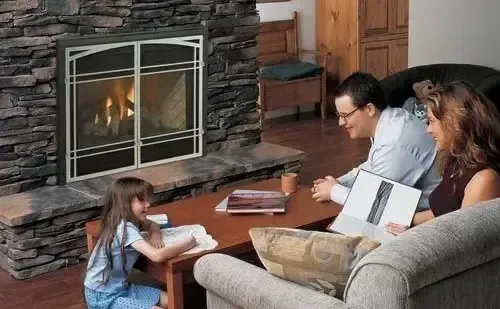
Gas Fireplace Repair
Chimney Works of installs and inspects a lot of gas fireplaces and gas log sets. While gas fireplaces generally require little maintenance outside of an annual inspection and cleaning, problems do sometimes arise. Some gas fireplace repairs we can address and others we recommend you contact a licensed gas plumber on the job. In either case, I’m betting you are here wondering what is going on with your gas fireplace, and what the steps are to have it repaired. Note that while we at Chimney Works love DIYers, we recommend that you call a professional immediately if you need gas fireplace repair. That being said, here are the top problems we see, and what professionals will do to fix them.
Note: Reading our article on how gas fireplaces work is a great place to start before diving into troubleshooting.
An annual inspection and cleaning will help fend off most of these problems. The NFPA recommends that all gas fireplaces be inspected and cleaned by a certified technician annualy.
We’ll Save You Some Reading If You Check These Things First
Ensure all valves to your fireplace are opened. Ask your husband/wife if they shut it off for any reason.
Check the batteries in your remote and if applicable, your receiver.
If your fireplace has a thermostat function, ensure it is set to the proper mode and temperature.
Check the batteries in your remote and receiver again. Yep, I said that twice on purpose. Use a battery tester.
Repeat your restart procedures a few times. Sometimes air or old gas is in the line.
My New Gas Fireplace Smells Funny
Odors from a new gas fireplace are expected and very common. The paint, dust, construction adhesives, and oils used in the manufacturing process will heat up and create an odor during what is called the ‘burn-in’ or ‘off-gassing’ period. The burn-in period is the first few fires of your new fireplace’s life or one long burn in your new fireplace. Consult your owner’s manual for specific instructions. This burn-in period actually helps cure the materials used in construction. If you still smell something after the burn-in period, and you have cleaned/dusted your fireplace, please discontinue use and call a professional.
You Smell Gas/Rotten Eggs Coming From Your Fireplace
Do you smell something that reminds you of rotten eggs around your fireplace? That is gas. If you smell gas, you need to leave the house and call a professional immediately. Even if we could recommend what might be causing it, we still want you to be safe.
You Notice A Lot of Soot
Soot is caused by unburnt fuel. If your gas fireplace is producing excessive soot, you will likely need to call a professional. They should be looking for clogged burner ports on your main burner, If you have a ceramic log set in your fireplace, they may have been moved and are not properly positioned. Manufacturers actually create your ceramic logs to go in a certain position inside your fireplace so that the flames take a particular route through or around your logs. If the flames from your burner take a different route, it is called impingement and can create excess soot as the flames hit the ceramic logs. Another reason for excessive soot is a bad fuel/air mixture ratio. A professional can adjust this for you.
Your Pilot Light Is Misbehaving
First, try your startup procedure a few times. When your gas sits for a while, like over the summer, air can be trapped in the gas line, and you may need to bleed that off before proper gas will come out.
If your pilot light keeps going out, you could have a bad thermocouple. This little device creates just enough electricity to keep the pilot valve open which allows gas to go through. If your pilot light stays lit but isn’t working otherwise, it could be that it needs to be adjusted. Professionals will know how to adjust your gas valve to set this properly.
Your Pilot Light Works, But Still Nothing
Likely your main burner valve is not opening when it should. If a thermostat is used, check that to ensure you didn’t set it too high. Check your batteries in your remote and if applicable, your receiver. Once that is checked, it could be your thermocouple or its counterpart, the thermopile. If your thermopile is bad, it probably isn’t producing enough electricity to keep the main gas valve open. Sometimes these are just dirty, and require cleaning with dry steel wool, and wiped clean with a dry rag.
Your Blower Isn’t Working
If you have a blower unit with your gas fireplace or gas fireplace insert, there are many reasons it may have failed. Provided it is plugged into a working outlet, it could just be an electrical or mechanical failure in the blower motor itself, which generally means a replacement. Otherwise, it could also be an issue with the thermostat. Many blowers have a connection that waits for your fireplace to heat up before the blower motor will kick on. If this connection is moved it may not be picking up the heat from your fireplace, or may just be bad and need replacement.
Your Remote Or Wall Switch Isn’t Working
First, check your batteries in your remote and receiver unit. If a thermostat is involved, check the settings there too. If that is in order, you are likely going to need to put in a call to the manufacturer. For wall switches, it could again be a bad or dirty thermopile that is not outputting enough electricity to make the main burner valve open.
My Gas Fireplace Is Making A Noise
Gas fireplaces do make some noise when in operation. Generally the newer the model the quieter it is. If you think the noise coming from the blower, that is covered above in this article. Otherwise, you may need a pilot light adjustment or a main burner cleaning.
My Fireplace Glass Is Foggy Or Has Condensation
Fog or condensation is normal when a fireplace is first turned on and is heating up. The fog on the fireplace glass will go away as the fireplace heats up. If what you are noticing looks like condensation but doesn’t go away after the fireplace is heated up, it may be a deposit left by the fuel as it burns. Try cleaning your fireplace glass more often to avoid this.

